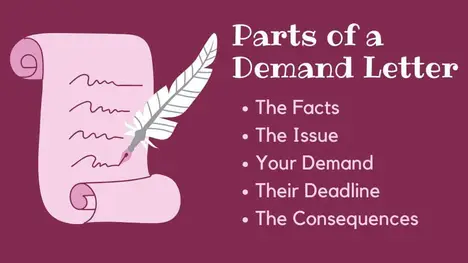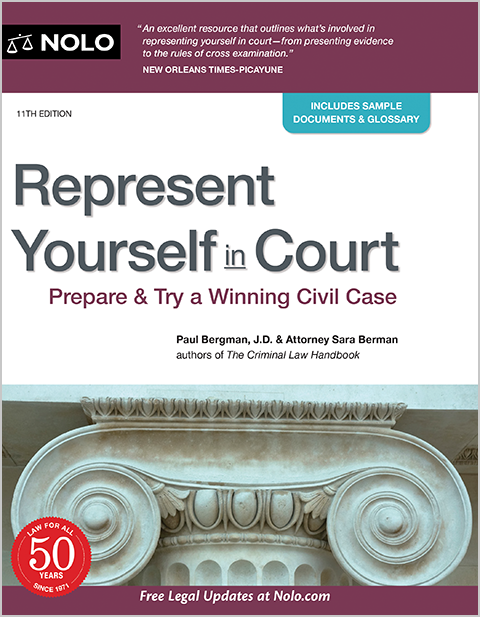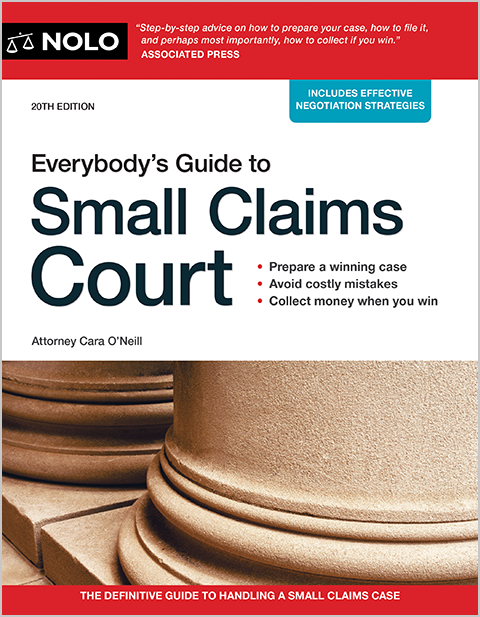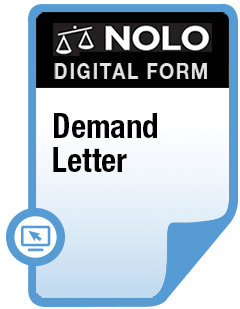Tips and sample language for writing the most effective demand letter.

 No one wants to go to court if resolving an issue without litigation is possible. That's why, for most disputes, the negotiation process starts by sending a demand letter. The demand letter opens a discussion between you and your opponent by explaining your side of the story, the amount you've incurred in bills, and the settlement amount requested. If your efforts to resolve the dispute fail after sending your demand letter, you can file a claim in small claims court.
No one wants to go to court if resolving an issue without litigation is possible. That's why, for most disputes, the negotiation process starts by sending a demand letter. The demand letter opens a discussion between you and your opponent by explaining your side of the story, the amount you've incurred in bills, and the settlement amount requested. If your efforts to resolve the dispute fail after sending your demand letter, you can file a claim in small claims court.
What Is the Purpose of a Demand Letter?
Demand letters are an essential part of dispute resolution and are used in almost all areas of law, including cases filed in small claims court. Whether used to collect unpaid debts or resolve breach of contract and property damage claims, demand letters define the issues needing resolution and, when well written, help facilitate settlement discussions.
Demand Letter Benefits
Many courts require litigants to try to settle the dispute before filing a lawsuit. A demand letter is the perfect vehicle for this because the letter itself serves as proof of having satisfied the legal requirement while providing other benefits, as well.
Promotes Case Settlement
One benefit of a clear, concise letter demanding payment is that you might not have to face the trouble of filing a small claims case. Even if you have unsuccessfully argued with your adversary in person or over the phone, laying out why you're owed money in a letter shows action.
Now, your opponent knows you mean business and must accept that you won't simply go away. If you sue, defending a case will take time and energy, and you might win. In short, your chances of getting paid will increase when you make your case in writing.
Helps Organize Your Case
Writing your demand letter forces you to think through every aspect of your case—and you'll be glad you did it because there's more to a small claims court case than filling out the "claim" form that starts the case. You must also explain your case clearly to a judge and prove your case with evidence.
When you write a demand letter, you present your case on paper. You'll explain what happened by providing "the facts" and state the law that applies to your case. You'll also describe the evidence in your favor—and possibly provide copies of invoices and photographs—and explain why you'll prevail. Because you must do the same thing in court before the judge, you'll be better prepared to litigate if needed.
Therefore, even if writing a formal demand letter isn't legally necessary, a demand letter could help you settle the case. And, if it doesn't, explaining your position in a formal letter allows you to document and organize your case before presenting it in court.
Informal Settlement Negotiations
Attempting to resolve the problem informally by phone or email—possibly even through an in-person meeting if you're on friendly terms—can be an excellent place to start. Before reaching out, you'll want to develop a negotiation strategy and determine how much you need to recover or what action you desire.
You'll review invoices, contracts, or other documents to determine how much you're out of pocket and what you want your opponent to pay. These calculations help you know when to walk away so you don't accept less than you need.
Also, if the initial round is unsuccessful, it will prevent you from falling into the trap of later asking for more. It's natural for people to become angry when the demand amount increases.
When You'll Need a Demand Letter
If your attempts to settle the matter informally fail, follow up with a demand letter. You can document the previous interactions, formally offer to resolve the matter, and emphasize what you'll do if the demand isn't met—usually filing a lawsuit.
You can also skip informal settlement negotiations and send the demand letter before filing an action. Many courts require you to formally demand payment before filing your lawsuit, and you'll need the letter to document that you complied with the requirement.
Learn more about preparing evidence for your small claims court case.
Demand Letter Components
Understanding the critical components of a demand letter is essential because every demand letter should have certain elements. Here's a short list of what you'll want to include:
- Facts of the case. An outline of what happened.
- Statement of the issue. A brief description of the problem.
- Demand. The dollar amount or action necessary to resolve the case.
- Response deadline. The date by which the recipient must respond.
- Noncompliance consequences. What will happen if the demand isn't met.
Below, you'll find more details about demand letter basics if you'd like to dive deeper into what to include, how to send it, and why.
Be Polite
Don't personally attack your adversary, even if you believe it's deserved, because it invites the other side to respond similarly. Calm people are more believable because it demonstrates their confidence in their position, including when presenting an argument in court.
Include the Facts
At first, it might seem odd to outline these details. After all, your opponent knows the story. But it isn't always the case. Many people remember only the facts supporting their side, and your job is to ensure they remember everything that happened. Also, if you end up in court, a judge could read the letter, and you'll want the judge to understand what transpired. In essence, this is an expedited way to record the dispute and events afterward, including subsequent phone conversations, unanswered calls, and inappropriate conduct by the defendant.
Explain your Damages
You'll list the actual losses you suffered, such as the cost of medical visits, lost income, repair costs, and property damage. It's a good practice to include receipts, invoices, and repair estimates after deleting sensitive information, such as credit card account numbers. Photos of damage are also helpful.
Ask for More Than You Want
You'll want to pad your opening demand whenever you are dealing with sophisticated negotiators and are asking for an amount over and above actual damages, such as pain and suffering, punitive damages, or "blue sky" in a business deal. For instance, if you want to settle for $20,000 total, you won't lead with that amount because you won't have room to negotiate. You'll ask for more. If you don't, your negotiations will likely stall. Why? Because attorneys and businesspeople who negotiate regularly assume you left room to negotiate and expect you to move off your initial request. Brush up on typical negotiation strategies, if necessary.
Set a Deadline
One week can create urgency, but two weeks is usually best, especially when dealing with insurance representatives and others who don't have the authority to settle the matter. Any longer won't create enough motivation to deal with you right away. Clarify the deadline by providing an actual date. If you plan to pursue legal remedies if the recipient fails to pay your demand, conclude by stating it.
Make and Keep Copies
Make a copy of each letter and the post office receipts when using certified mail, return receipt requested. If you send it by email, be sure not to delete it. Keep all correspondence from your adversary.
When to Use Certified Mail
Many individuals and businesses use email almost exclusively, and emailing all communications is okay. (However, while email is quick and commonly used, a mailed letter can make a more profound impression.) If you don't receive a response to an emailed demand letter, send it by certified mail, return receipt requested. If you end up in small claims court, you can use the return receipt to refute a claim that your opponent didn't receive the demand letter.
Preparing to Write the Demand Letter
You're correct if you sense there's more to writing a persuasive letter than stating facts. In a nutshell, being diplomatic will go a long way, both when writing a demand letter and presenting the case in court.
Develop the Tone
To help you achieve the right tone, try to put yourself in the recipient's shoes. How would you react to the letter? Anticipating how the recipient will respond can help you frame your demand more persuasively.
Remember, someone will acquiesce more readily if they perceive a benefit or decide to settle the case. Threats of an adverse action or potential punishment can work, but they're less effective. When possible, frame the letter so the recipient concludes that settling would be best.
Keep Your Goal in Mind
Because you want your opponent to settle the case, your goal isn't to anger the recipient. Instead, encourage your opponent to assess the situation in a business-like way rather than incite emotionality.
You want your letter to raise the following questions in the mind of the "defendant" or the person or business you're suing:
- How much time will a defense take?
- Do I want this dispute resolved in public?
- Will I lose?
- How much will it cost me if I lose?
- Can I settle this now for less money?
Remember that you won't write those particular questions in the letter but rather compose it in a way that makes your opponent think about the issues.
Mistakes to Avoid
Typewritten letters look more professional than those that are handwritten. If you don't have computer access, visiting the local library will be well worth the trip. Other things to remember:
- Don't be overly aggressive or emotional. Maintain professionalism and objectivity.
- Don't include unnecessary details. Provide all relevant information to support your claim and avoid topics not directly related to the situation.
- Don't forget legal requirements. Be aware of any legal standards that apply.
Once complete, consider how the recipient might respond and how open the recipient will be to the demand. The goal is to encourage the recipient to reflect on the situation, assess their involvement, and conclude that the best course of action would be to settle.
Sending the Demand Letter
Your options will include certified mail, email, or personal delivery. Whichever method you select, keep a copy for your records and document all correspondence for future reference.
After sending the demand letter, allow reasonable time for the recipient to reply. When you receive it, evaluate it and determine whether the response meets your expectations. If not, consider replying. It often takes time, effort, and several rounds of communication to resolve a dispute.
If you don't receive a response by the deadline, proceed with your strategy, such as suggesting mediation or initiating legal proceedings.
Sample Demand Letters
Below are letters a consumer might write to an auto repair shop after being victimized by a shoddy repair job and to a contractor who ruined a remodeling project.
Car Repair Letter
|
June 16, 20xx Tucker's Fix-It-Quick Garage Dear Mr. Tucker, On May 21, 20xx, I took my car to your garage for servicing. Shortly after picking it up the next day, the engine caught fire. Fortunately, I was able to douse the fire without injury. As a direct result of the engine fire, I paid the ABC garage $1,281 for necessary repair work. ABC garage indicated that your failure to connect the fuel line to the fuel injector properly caused the fire. I enclose a copy of their invoice. Also, I was without my car for three days and had to rent a car to get to work. I enclose a copy of an invoice showing the rental cost of $145. In a recent phone conversation, you claimed that the fire wasn't the result of your negligence and would have happened anyway. And you said that even if it was your fault, I should have brought my car back to your garage so you could have fixed it at a lower cost. As to the first issue, Peter Klein of the ABC Garage is prepared to testify in court that the fire occurred because the fuel line wasn't correctly connected to the fuel injector, the exact part of the car you were working on. Second, I had no obligation to return the vehicle to you for further repair. I had the damage you caused repaired at a commercially reasonable price and am prepared to prove this by presenting several higher estimates by other garages. Please send me a check or money order for $1,426 on or before July 15. If I don't receive payment by that date, I'll promptly file this case in small claims court. After obtaining a money judgment, I will use all legal avenues to collect it. It also will be part of the public record available to credit agencies, You can reach me during the day at 555-555-2857 or in the evenings until 10 p.m. at 555-555-8967. Sincerely, Marsha Rizzoli |
Home Contractor Letter
|
June 20, 20xx Beyond Repair Construction Dear Sirs: You recently did replacement tile work as a part of a remodeling project on my downstairs bathroom at 142 West Pine Street. Per our written agreement dated May 17, 20xx, I paid you $4,175 to complete the job. Problems with your work surfaced two weeks later when, on June 1, the tile in the north portion of the shower had sunk almost half an inch. Water pools in the corner because of the uneven shower floor, causing slow drainage. When we spoke on the phone, I didn't appreciate the insinuation that I imagined the problem and that if the issue existed, it was minor. Because I did not receive the competent remodeling job I paid for, and you refuse to remedy the problem, I must hire someone else to fix the shower, and I am demanding that you pay the costs. I am enclosing a $1,200 estimate to level the shower floor from ABC Tile. Please remit $1,200 within ten days. If I don't receive the funds by June 15, 20xx, I will file a lawsuit in small claims court. Sincerely, Ben Price |
Additional Help
If your demand letter doesn't work, find out when you should sue in small claims court. For more help preparing a small claims case, see Everybody's Guide to Small Claims Court, by attorney Cara O'Neill (Nolo).



